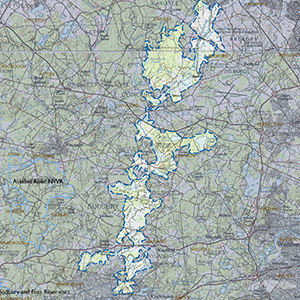Important Bird Area Sites in Massachusetts
Important Bird Area: Sudbury/Concord River Valley
Site Summary
Nominated By
Steve Ells, Ken Harte, Elissa Landre, Ron Lockwood, Marj Rines, Simon Perkins
Size
12,500 acres
Towns and Counties
Bedford, Billerica, Carlisle, Concord, Framingham, Lincoln, Sudbury, Wayland; Middlesex
Ownership
US Fish and Wildlife Service, private, nongovernmental organization
Major Habitats
cultural grassland, cultivated field, emergent freshwater wetland, palustrine woodland swamp, shrub-scrub wetland, lake/pond, river/stream, migratory stopover site
Land Use
nature & wildlife conservation,/land trust, hunting/fishing, other recreation or tourism, agriculture/livestock, fisheries/aquaculture, utility/right-of-way, research
Serious Threats
non-native invasive plants, pesticides, residential/commercial development
Minor Threats
disturbance to birds or habitat, noise pollution from Hanscom Field flushes birds
IBA Criteria
- Category 1: Sites important for long-term research and/or monitoring projects that contribute substantially to ornithology, bird conservation, and/or education.
- Category 2: Sites containing assemblages of species characteristic of a representative, rare, threatened, or unique habitat within the state or region.
- Category 4: Single-species Concentrations: The site regularly supports significant concentrations of a flocking species, but may not meet the thresholds above. The site should support a higher proportion of a species' statewide population (more than 1%, if known) than other similar sites.
- Category 5: Land Birds: The site is an important migratory stopover or seasonal concentration site for migratory land birds (e.g., warblers). Sites may also qualify on the basis of supporting exceptionally high densities of breeding species as shown from point counts or other surveys or if they represent "migrant traps" relative to surrounding areas. Strong consideration will be given to areas with consistently high overall species diversity..
Site Description
The refuge (including Great Meadows National Wildlife Refuge and Estabrook Woods) runs along 12 miles of the Sudbury and Concord Rivers. Habitats include freshwater marsh, wooded swamp, rivers, streams, ponds, human-made impoundments, floodplain with some upland forest, cultivated grassland and cultivated fields. Some habitat types extend beyond the ownership boundaries of the wildlife refuge. This IBA is an archipelago of habitats: the river's expansive wetlands linking islands of forest and open land. On a property-ownership map, though, it appears to be a mosaic of conservation ownerships and of fee titles, easements, and restrictions. Indeed, the assembly of these properties over more than 50 years has been a triumph of conservation activism and generosity. This archipelago is even more impressive biologically because it is buffered by a wildlife corridor. Though surrounded by growing urbanization, this mostly preserved corridor is a partial answer to concerns that the state's conservation lands would become small, biologically isolated islands (M. Primack. 1987. "Marooned in Massachusetts" Sanctuary, Massachusetts Audubon Society). Ludlow Griscom wrote in 1949: "A greater number of competent and nationally-known naturalists and ornithologists have explored [this valley's] coverts than any other corner of the New World. Their records and data validate the interesting and sometimes profound changes that have taken place."
Current Conservation Status
Both national wildlife refuge and other public and private conservation ownership. The area is a federally declared Wild and Scenic River for 29 miles running from the Ashland Dam. Invasive plants posing serious threats to native vegetation include Purple Loosestrife, Water Chestnut and Lotus. These plants are being managed by mechanical and biological means including water level management, hand pulling and introduction of insect predators. Cattails are being managed, mowed, pulled and algae in Hop Brook is being removed. Mercury pollution of the Sudbury River from the Nyanza Superfund Site in Ashland has lead to a fishing ban, and there is need for additional nitrogen removal at wastewater treatment plants in the watershed.
Ornithological Significance
The King Rail, Least Bittern, and American Bittern are confirmed or probable breeders in the Wash Brook area of the refuge. Eleven Pied-billed Grebes were observed in mid-April 1992. The following species have been recorded for the refuge: Short-eared Owl, Grasshopper Sparrow, and Northern Harrier. The refuge contains significant numbers of species of high conservation priority including nesting Black-crowned Night-Herons (Concord unit), American Woodcock, Black-billed Cuckoo, and the six species with more than one percent of their entire breeding population within Massachusetts: Eastern Phoebe, Gray Catbird, Blue-winged Warbler, Scarlet Tanager, Wood Thrush, and Baltimore Oriole. Ducks and geese in significant numbers on fall migration include Green-winged Teal, Mallards, Canada Geese, Wood Ducks, and mixed flocks of ducks and geese. Shorebirds concentrate in significant numbers on fall migration including mixed sandpiper/plover flocks of Semipalmated Sandpiper, Semipalmated Plover, Least Sandpiper, Baird's Sandpiper, American Golden-Plover, Hudsonian Godwit, Red Knot, Common Snipe, and White-rumped Sandpiper.
Wading birds including Great Blue Herons have been seen in significant numbers. Land birds including Snow Buntings, Bobolinks and American Pipits have been observed at the refuge. The significance of the site for long-term monitoring is well supported by data from observers including H.D. Thoreau, William Brewster, Ludlow Griscom, and Allen Morgan, as documented in Birds of the Sudbury River Valley: A Historical Perspective, by Richard K. Walton.
*Complete list of species available from the Pine Hill-Flint's Pond area bird list (limited to state-listed rare species & Partners in Flight priority species, plus typical lake & forest quality-habitat birds under IBA category 4)
**Complete list of species available from Avifauna of Estabrook Woods (data compiled from a database of high counts in a single day over a period of 36 years of birding by K. Harte).
Other Flora or Fauna of Significance
Blanding's turtle are present at the refuge. Britton's violet, a state-listed treatened species, is found on the refuge.
The state-endangered dragonfly, Ringed Boghaunter, was found at Estabrook Woods, 2001 and 2002.
Data Sources
Walton, R. K. 1984. Birds of the Sudbury River Valley. Mass Audubon, Lincoln, MA.
Unpublished data from Simon Perkins and Ronald Lockwood
Avian records from Bird Observer published and unpublished records.
Lockwood, R. B., and K. J. Harte, compilers. 2002. Avifauna of Estabrook Woods: Data provided by K. Harte, R. Lockwood, and R. Walton. www.walden.org/scholarship/e/ells_steve/estabrook/birds.
N. Levey and S. Ells. 2002. Pine Hill-Flint's Pond IBA Nomination Species Data.




